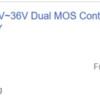So we're on the same page, I believe you're referring to this OGR thread from 2013, and this short video clip from that thread albeit of a trolley as I don't have a subway set:
So what exactly is your setup? Have you settled on where power comes from, quantity and spacing of LEDs, etc.? Are you comfortable working at the tiny-component level (e.g., resistors, capacitors, diodes), soldering, digital meter measurements, etc.?
As to the delay idea. My first thought is a DC-powered relay timer module. These are just a few bucks and can be programmed with 0.1 sec digital precision. When triggered, the relay turns on or off after some settable time interval. I figure something like this could be the core component of a delay mechanism - obviously i's to dot and t's to cross.
Note that if you search for "delay timer module" on eBay or Amazon or wherever I'd say 99% of these timer modules have a relay output. This can be somewhat annoying that the relay is clicking multiple times every time the subway passes; of course the relay sound is likely drowned out by the train itself but just saying. The particular timer module above is also available in a solid-state, non-relay version that operates silently.
If this approach looks like something that might work for you, I can expand on the idea.
----
Separately, as to the randomizing effect, if you use the delay method it seems to me you could get in a situation where the behavior becomes consistent/repeatable. For example at some speed, when the subway comes around to the sparking circuit it will always trigger on the leading wheel axle. Then the delay kicks in blocking the next 3 axles on the lead car, so the leading wheel axle on the 2nd car sparks, the exact same delay kicks in blocking other axles on 2nd car, and the leading wheel axle of the 3rd car sparks, etc.
So this is one of those measure-twice, cut-once situations. Best to experiment as much as possible with the effect you're trying to create before boxing yourself in. I mentioned the 0.1 sec precision of most of these low-cost timer modules since this allows you to do-the-math for your particular subway setup. That is, you know the wheel axle spacing and can plan out exactly how far apart multiple spark sites are located.
For example, these timer modules can be programmed to cycle on/off...say 1.0 sec ON, then 2.0 sec OFF forever. Suppose your LED circuit was powered like this. This would also be a form of randomization as the axle would only spark when crossing the trigger IF the timer happened to be ON. This would allow the case where the leading axle on the front car might not spark! This could be a more interesting effect.
Or, using multiple timers, you could only activate the sparking when the train speed exceeds some speed. I'm speaking from ignorance but I'd think there would be less sparking at slow speeds(?). Also, this qualified sparking could address the 0 MPH (stopped) situation that was discussed in the linked thread. I'd think you wouldn't want the LED steady-on if the subway comes to rest with a wheel on the trigger section.








